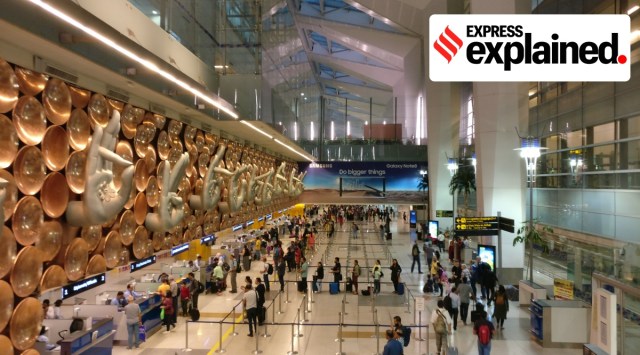Why are delays being reported at Delhi airport’s Terminal 3?
As the peak travel season begins, here is a look at what is happening at the Delhi airport, what’s being done to fix it, and why you should make your travel plans accordingly.
 Many passengers have reported issues of congestion when passing through Terminal 3 of the Delhi Airport. (Representational photo via Wikimedia Commons)
Many passengers have reported issues of congestion when passing through Terminal 3 of the Delhi Airport. (Representational photo via Wikimedia Commons)Union Civil Aviation Minister Jyotiraditya Scindia visited the Delhi airport on Monday (December 12) as some passengers continued reporting issues of long security check queues, delays in boarding and a lack of smooth management while travelling through Terminal 3 (T3) of the Indira Gandhi International Airport in the past few days.
“The actions points that we have decided, together as a collective today, hopefully, we’ll see a resolving of this in the next 10 days,” Scindia told a news channel after his visit.
As the peak travel season begins, here is a look at what is happening at the Delhi airport, what’s being done to fix it, and why you should make your travel plans accordingly.
What’s the delay at Delhi airport all about?
Social media is currently flooded with videos and photos of passengers who are showing scenes of chaos at the airport. While one passenger told The Indian Express there was difficulty in getting inside the airport, another said it was at the security check that some machines were not working, slowing movement.
A few passengers also said on Twitter that they missed flights due to the delays, and had to reschedule tickets at the last minute.
Why are such scenes being witnessed?
According to officials at the airport, this has to do with the fewer counters, smaller space, more passengers and limited security staff. Some of the congestion may also have to do with the increased number of travellers at the end of the year, after two successive years of Covid ended up slowing down tourism in general.
Scindia said, “We have gone from a Covid era of zero passengers to actually surpassing the pre-Covid numbers.” After the third wave of Covid earlier this year saw comparatively lower rates of hospitalisation, travel has seen a boost in India. In November this year, for instance, tourist footfall was three times more in Himachal Pradesh as compared to the previous year.
Therefore, some airlines are asking passengers to reach the airport at least three-and-a-half hours before their flight’s scheduled departure.
What is being done to fix these issues?
The Delhi International Airport Limited (DIAL) said it is working to cope with the demand at T3, and arranging the deployment of additional systems and manpower. “We have deployed additional manpower to guide passengers, especially at key choke points, and shifted one additional X-Ray machine. Additional manpower requirements will also have to be addressed by all stakeholders, including Central Industrial Security Force (CISF) and Immigration, to further improve the situation,” it said on Saturday.
The T3 manages over 500 domestic and 250 international flights and a daily passenger load of 1.9-1.95 lakh, making it the busiest point of the airport. As per DIAL, they have reduced the number of flights for decongestion – from 22 flights per hour (pre-Covid) to 19 flights per hour (November 2022).
After a meeting was held on the matter, Scindia had said in a tweet on December 7 that some initiatives were outlined, such as planning for peak-hour capacity at major airports, assessing x-ray capacity for baggage and long-term technological upgrades for faster processing of baggage and security.
He said on December 12 that a discussion was held with stakeholders such as the “CISF, Directorate General of Civil Aviation (DGCA), DIAL and all the airlines”. They also studied bottlenecks at the airport and how to ease them.
The 16 gates at the departure were identified as one bottleneck and the number of gates has been increased now. The minister also said he asked for waiting times to be displayed at all gates of entry to allow passengers to move towards less crowded areas and reduce the load on the system.
Usherers were also to be introduced to guide people towards less crowded entries. He added that despite reports of some snags, the greater the adoption of the recently introduced face ID system Digiyatra, the easier it would be in facilitating entry.
In the security lines, the Automatic Tray Retrieval System (ATRS) was identified as a source of clogging as well. The number of gates here will also be increased further and the CISF has also put in the requisite staff to cope with the increase.
- 01
- 02
- 03
- 04
- 05






































